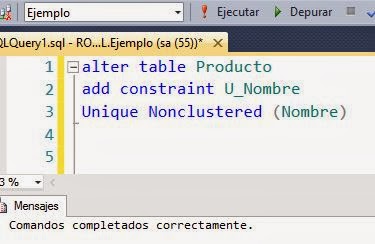A unique constraint is a single field or combination of fields that uniquely defines a record. PostgreSQL UNIQUE constraint example. Two NULL values for a column in different rows is different and it does not violate the uniqueness of UNIQUE constraint. When a UNIQUE constraint is adding, an index on a column or.

Adding a unique constraint will automatically create a unique B-tree index on the column or group of columns listed in the constraint. A uniqueness restriction covering only some rows cannot be written as a unique constraint , but it is possible to enforce such a restriction by creating a unique partial index. But if you have non- unique entries on your table, it will fail. Here is the how to add unique constraint on your table. I know the thumb rule of UNIQUE Constraint is, UNIQUE Key column can be a NULL.
In the COMPANY table, for example, you might want to prevent two or more people from having identical age. Not null constraints are a great way to add another layer of validation to your data. Sure, you could perform this validation in your application layer, but shit happens: somebody will forget to add the validation, somebody will remove it by accident, somebody will bypass validations in a console and insert nulls, etc. To create a unique constraint. In Object Explorer, right-click the table to which you want to add a unique constraint , and click Design.

The unique index is just a tool the constrain uses to perform its function. This index will be created automatically when you add the constraint. Make a Column as PRIMARY KEY.
Consider the following table named students. No column in this table is marked PRIMARY KEY. Now, we will make the column id as PRIMARY KEY. Once you define the UNIQUE constraint , you can insert N number of NULL values for that column which is the principal rule of UNIQUE Constraint.
What if I need an only single NULL record for UNIQUE Column, we should check the below demonstration. APPLIES TO: SQL Server Azure SQL Database Azure SQL Data Warehouse Parallel Data Warehouse UNIQUE constraints and CHECK constraints are two types of constraints that can be used to enforce data integrity in SQL Server tables. Both the UNIQUE and PRIMARY KEY constraints provide a guarantee for uniqueness for a column or set of columns. The UNIQUE constraint ensures that all values in a column are different. Unique Constraints and Check Constraints.
A PRIMARY KEY constraint automatically has a UNIQUE constraint. However, you can have many UNIQUE constraints per table, but only one. Most of the time, we add unique constraints to a table when we create them. Sometimes, we forget or don’t realize we need one until after the fact.
The value must be known from the first insert (which means the columns are declared not null) and the value is never updated. Actually, a better case would be a simple unique constraint where we just exchange two rows. Sometimes we may decide to add a new constraint to an existing table (to see what are the different types of constraints that can be placed on a database table, please refer to the CONSTRAINT section).
The Value of the column must be unique across the whole table. If you want to add a unique constraint to a column or a group of columns using existing unique index. Let’s take a look at the following steps.
The task is to add a foreign key constraint in a certain table. In order to perform it, there are a few step create the necessary table to simulate it. The following are steps to execute in the form of several activities.
Having a unique constraint on a table is there a way to avoid FME stoping the bulk copy or insert simply ignoring the duplicate values and keep on with the translation, just reporting the warning ? They are functionally the same and unique constraint will create a unique index. Distinguishing between NULL values is impossible, as per SQL standard. These are my favorite workarounds for one and multiple columns. There is a long discussion on why nullable columns with a UNIQUE constraint can contain multiple NULL values.
The short version is that NULL represents missing information and comparing a field with missing information with another makes no sense. So it can be said that the PRIMARY KEY of a table is a combination of NOT NULL and UNIQUE constraint.
Brak komentarzy:
Prześlij komentarz
Uwaga: tylko uczestnik tego bloga może przesyłać komentarze.